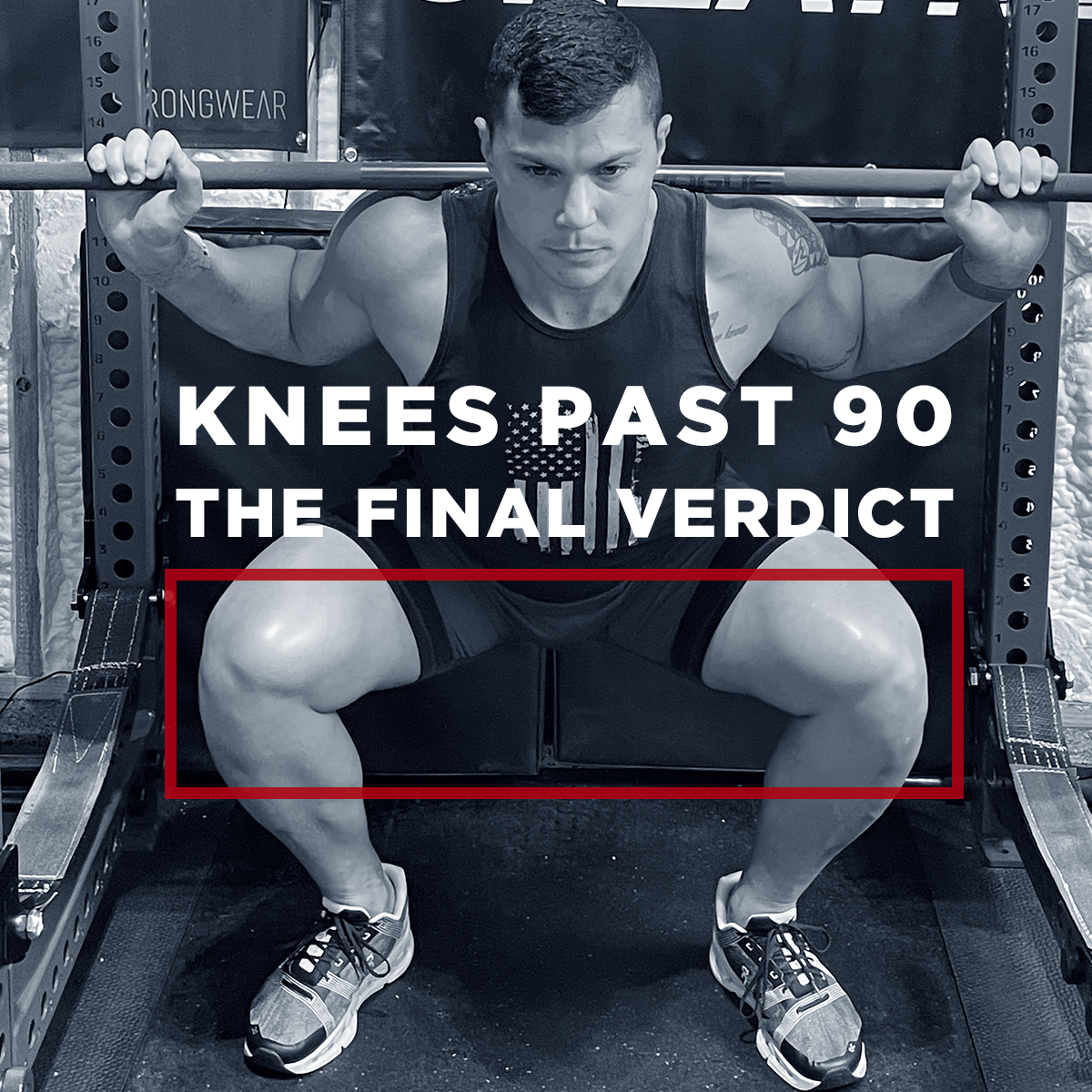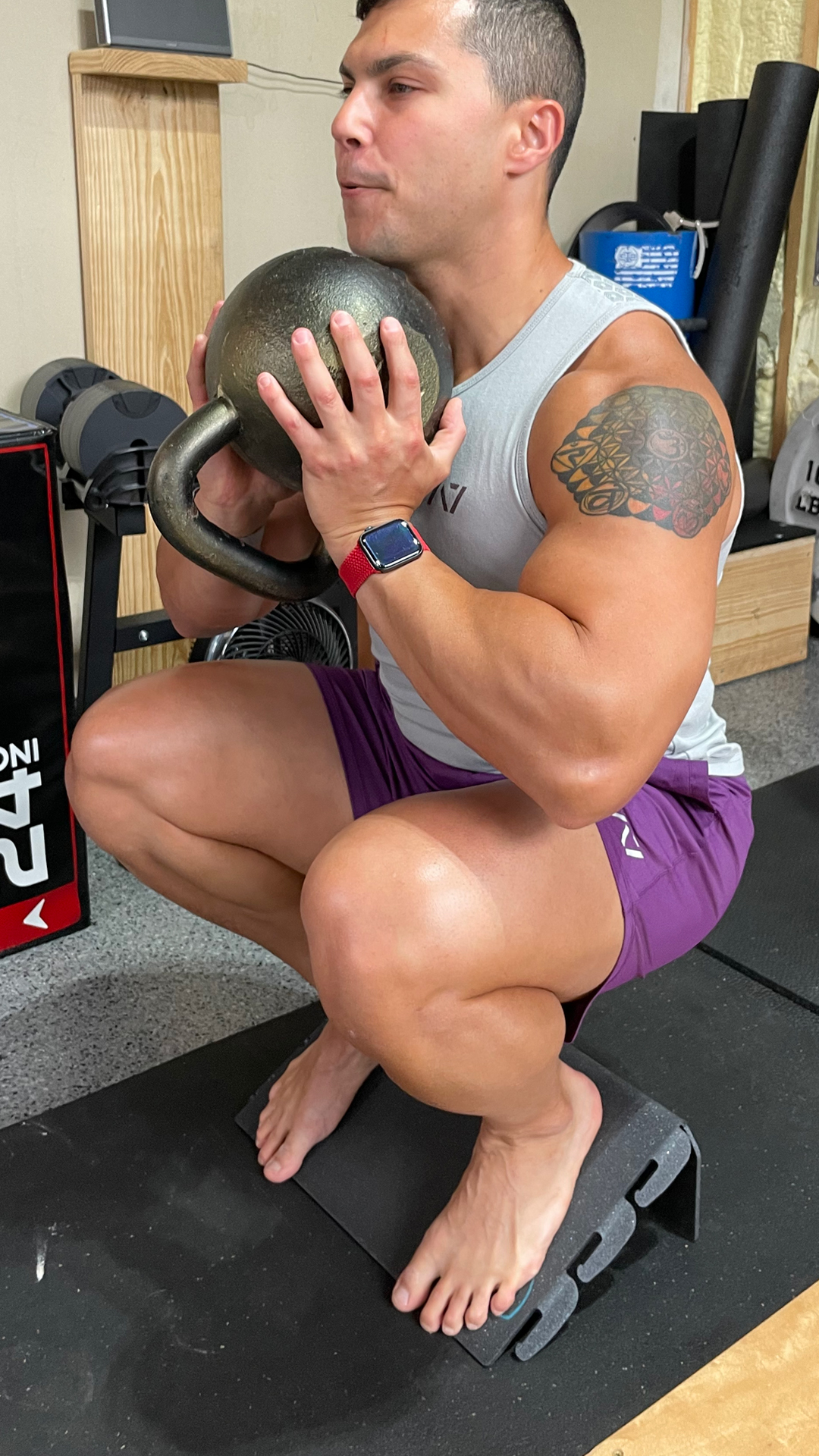Blog
Knees past 90 degrees? The Final Verdict.
One of the biggest fitness movements in recent memory has been the resurgence of knees over toes training. Notice I said resurgence and not brand new amazing fix; more on that later.
Knees Past 90 Degrees

One of the biggest fitness movements in recent memory has been the resurgence of knees over toes training. Notice I said resurgence and not brand new amazing fix; more on that later. Ben Patrick, aka knees-over-toes guy, has been all the rage over the last few years. He’s been backed by celebrities and athletes and has even been on Joe Rogan (that’s how you know you’ve made it).
Somehow, this training style became completely taboo over the years and is broadly misunderstood. One of the popular terms to describe the style is bulletproofing your knees. The premise is based on not being afraid to let your knees travel over your toes or squatting lower than 90 degrees.
In the same way, you see kids wearing fashion from the 90s and claiming it’s brand new. It happens with fitness as well. Just look at the countless elite weightlifters with some of the strongest squats or Olympic lifts of all time, who squat to the floor and let their knees track over their toes on every rep. The popular ATG split squat has been around since the 50s and 60s. Even the Hindu squat has been around for thousands of years. Legendary strength coach Charles Poliquin has also gone into deep detail in his certification coaches.
Although it may not be as new and innovative as it’s made out to be, the knees-over-toes guy has done a fantastic job bringing this information back and challenging many current trends.
Too deep or Too Shallow
So how did we get to this point? Over the years, the experts have said squat to parallel with the floor, which is around 110 degrees and not the 90-degree angle they thought. 90-degree joint angles have also been very popular, but this is slightly above parallel. For years half/quarter squats were getting torn apart on social media for not being deep enough, and now we’ve swung entirely in the other direction. ATG, or ass to grass, has been the new standard for what makes a real squat.
Let’s back up and make one thing clear first. Restricting your knees from tracking forward over your toes during a squat will shift the torque from the knees to the hips and lower back and can lead to injuries and pain1. The knee is a synovial joint, meaning synovial build delivers nutrients to the knee. This process happens when the knee moves in flexion and extension. To get the full benefits, you must fully extend and flex the knee, which requires your knee to go over your toes2. This research shows that a deep squat is better for your knees and does not increase the risk of injury.
You are always using these knees over toes movements in your everyday life. Walking down the stairs, kneeling on the ground, standing up from sitting on the toilet or your desk, bending down to grab something, or sprinting all involve your knees going over your toes.
It’s not magic
What I mean by this is squatting past 90 degrees or doing tons of knees over toes exercises isn’t a guaranteed fix for everything. The fitness world can be great at doing the “my way is the only way that will help, and everything else sucks” method.
This training style is just a position, movement, or extreme range of motion. If you haven’t been doing this and jump right into deep knee flexion training, you will likely run into some patellofemoral pain. Like any brand-new training stimulus, you must follow a proper program and progress slowly. Muscles, bones, ligaments, tendons, cartilage, and even intervertebral discs can all get stronger when loaded, but they will send you a pain signal if you jump too much too fast.
Often you see people performing these exercises with extreme lumbar lordosis. This means that the movement is driven by the spinal erectors, which is not what you are chasing. They need to be trained with a more natural trunk and pelvic position. The problem is that sometimes just because it looks like you are getting ass to grass doesn’t mean the movement is better. Sometimes your body will twist and contort to do what you ask, and you may be getting past 90 degrees, but your body may be getting in a worse position to make it happen.

Finding your depth
It’s important to remember that literally everybody on the face of the earth is built slightly differently. This means that things like hip socket depth, limb length, injury history, imbalances, and training history will play a role in determining how someone's squat looks.
Before diving further into knees over toes, just look at a high bar and low bar back squat. You could place two lifters who look similar next to each other, and with their different proportions, one could prefer a high bar back squat with a more vertical torso, and the other would thrive with a low bar back squat with more of a hinge movement. Is one of these wrong? No way. It simply shows that each person will have different biomechanics and squat patterns, and finding the best variation for your body will be important.
On top of that, you need to start thinking about your maximum depth vs. your ideal depth. Your one rep max will likely aim more toward your ideal depth, and for some people, that’s 90 degrees; for some, it’s parallel; and for some, it’s ATG. In my experience, having your minimum depth for heavier lifts is ideal, but training the extreme range of motion in other lifts or sets is also important.
Weak muscles feel like pain
I cannot count how often I’ve heard someone say they have bad knees and cannot do legs. Now there may be some cases where this is true, but most of the time, the pain feeling needs to be reframed. Remember that pain is a signal sent from your body to your brain and can mean many different things. It can mean something is weak, it can be a neurological response where your body is protecting you against a movement it’s unsure about, and of course, it can be an actual injury.
Rest assured that a lot of the time, unless you have a severe injury history, it’s likely that something is weak. If you’ve been avoiding knees over toes or squatting past 90 degrees, you likely have a weak quad but also a weak ankle and tibialis anterior. Weak things break easier, and that is true of everyone's body. The stronger your joints are, the more force they can withstand. You need to be confident and able to access the full range of motion in your joints and then create stability in those joints. That is what strength really is.
Avoiding your weaknesses has never been the solution. You will need to figure out what exercises and progressions you must follow to strengthen the problem areas that are bringing you pain.
The knee is in the middle of two important things.
Whenever you encounter knee pain, you must realize that the knee is at the mercy of the hip and the ankle, similar to how the elbow is to the shoulder and hand. The thing in the middle is where the symptoms are usually displayed.
If you have ever seen someone walk that is extremely pigeon-toed, they likely, at some point or another, experience knee pain. This pigeon toe of the foot often results from extreme internal rotation of the hip or possibly a past ankle injury that your body is compensating to protect. The knee isn’t just bad; it’s more than likely unstable from your poor movement mechanics at the hip and ankle from everyday life. The point is that just because you have knee pain doesn’t mean you need to jump into tons of extreme knee flexion training.
Another forgotten piece of information is that the knee doesn’t just flex and extend. It actually needs to rotate as well. During the final 30 degrees of knee extension aka the bottom of the quat, the tibia or femur must externally or internally rotate about ten degrees3. For the knee to rotate, you must also focus on hip, tibia, and ankle rotation.
This tells you that deep knee flexion is excellent but only part of the puzzle. Our bodies are amazing, complicated systems, aren’t they?
How can you add this to your training?
By now, the sirens should stop going off in your head anytime you hear about knees over toes training or squatting past 90 degrees. It certainly is something everyone needs to be training to make sure you are working on a full range of motion.
Knees over toes guy have some great exercises in his arsenal that are not all just ATG squats past 90 degrees. Things like the backward sled pull, backward incline walk, Poliquin step down, ATG split squat, tibialis raise, reverse Nordic curl, nordic curl (link to blog), and heels elevated goblet squat are all great additions to your program. The key, like anything else, is adding these things slowly into your program and progressing them from whatever level you are starting with.
Ensure you are training each side unilaterally to fix any weaknesses or imbalances hindering you from moving correctly. For example, most people have never done a tibialis raise to strengthen the muscle in the front of their shin, yet they have done tons of calf raises. Similarly, the reverse sled pull helps reverse knee pain after years of doing everything moving forward. Finally, the Poliquin step-down is a simple addition to strengthen your quad's VMO muscles and dip your toes into knee over toes training.
Ok, so you’ve got some new exercises and concepts to take home to ensure you aren’t missing out on this full range of motion style training. If you are solely thinking about squatting past 90 degrees, I recommend starting with the heels elevated goblet squat and challenging yourself to see what your maximum and ideal depths are. Maybe add 2-3 sets of this after your normal squat routine and practice squatting past 90 degrees.
Keep an eye on how your body is feeling and if your knees are barking at you after a 5k you ran over the weekend, switch to your ideal depth or maybe sub out some exercises for something a bit more knee friendly. Training this range of motion is important, but too much too soon can lead to injury.
Remember that the pain can often be a signal that something else in the machine needs to be looked at. So as amazing as squatting past 90 degrees and knees over toes exercises can be, remember to take a closer look at surrounding areas to see if they are contributing to the issue.
Now get out there and start training those joints in a safe full range of motion!
About the Author

Travis Halena is a personal trainer with 14 years of experience that includes training professional athletes, teaching group fitness classes, designing programming and choreography for gyms, and one-on-one sessions with every type of client you can imagine. He is constantly learning and evolving to see what works and what doesn’t so he can help clients sift through the never-ending fitness content that’s available today. Travis aims to help everyone move pain-free, feel like an athlete, and look good doing it while fighting father time. After playing baseball and basketball at a high level, he now trains in Jiu-Jitsu when he isn’t with his family and dogs.
- Fry, A.C., Smith, J.C. and Schilling, B.K., 2003. Effect of knee position on hip and knee torques during the barbell squat. The Journal of Strength & Conditioning Research, 17(4), pp.629-633.
- Hartmann H, Wirth K, Klusemann M. Analysis of the Load on the Knee Joint and Vertebral Column with Changes in Squatting Depth and Weight Load. Sports Medicine. 2013;43(10):993-1008. doi:https://doi.org/10.1007/s40279-013-0073-6
- Zarins B, Rowe CR, Harris BA, Watkins MP. Rotational motion of the knee*. The American Journal of Sports Medicine. 1983;11(3):152-156. doi:https://doi.org/10.1177/036354658301100308
Ironmaster has been specializing in producing the best home gym equipment since 1978. Check out Ironmaster.com to learn more about our equipment, like our legendary Super Bench Adjustable Weight Bench, the unrivaled Quick-Lock Adjustable Dumbbells, the customer favorite IM2000 Self Spotting Machine (Smith Machine style half rack!), and of course learn how to build a custom package to take advantage of our everyday discount program.
keywords: knees, knee health, knee mobility, knees past 90, injury prevention, mobility, health, fitness

2 Comments